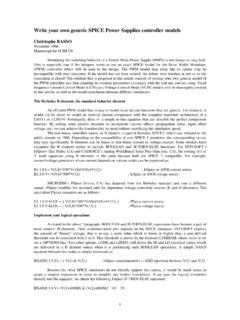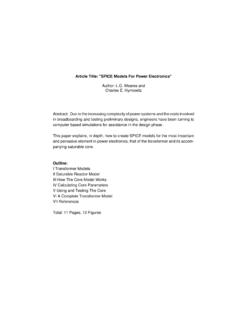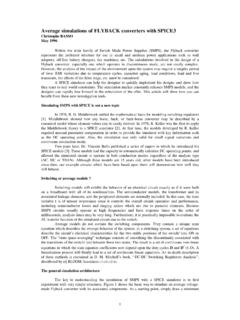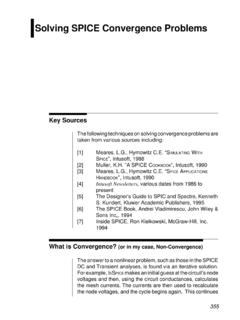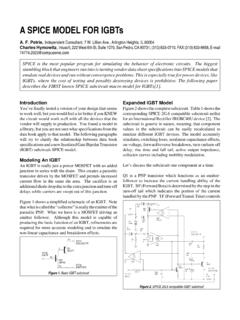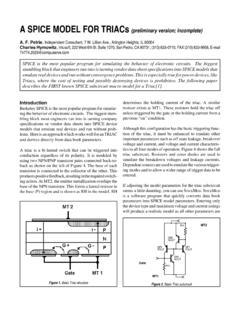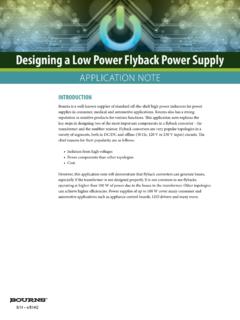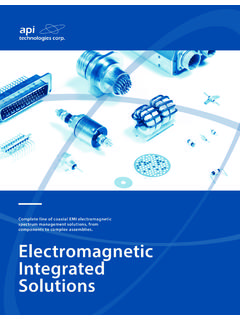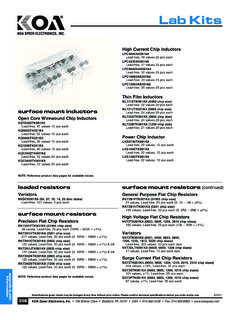Transcription of Modeling Non-Ideal Inductors in SPICE - Intusoft
1 IntroductionModelling of Inductors and inductive elements in SPICEhas always been of low importance to analogue is partly because SPICE was developed primarily forIC design where inductive elements are usually parasitic andvery widespread use of SPICE for discrete analogue circuitdesign has seen the program being used to analyze switch-ing power supplies and filters in which the behaviour of theinductive element is critical to the accuracy of the simula-tion. In general these circuits operate using ideal inductorsreasonably well since the current and frequency of opera-tion are in the ideal operating region of the Inductors used( relatively low frequency and well below the saturationcurrent limit).More recent applications employing inductive elements areelectromagnetic interference (EMI) filters, in which the reso-nances across a very wide range of frequencies needs to beexamined.
2 Likewise employing Inductors in dc supply fil-ters can put the inductor near its dc saturation region. Inboth later cases the modelling of the Non-Ideal behaviour ofthe inductor is important for accurate predictions of Inductor BehaviourIn an ideal inductor the impedance (Z) is purely reactiveand proportional to the inductance (L) only; The phase ofsignal across the ideal inductor would always be +90 out ofphase with the applied voltage and there would be no effectof DC current bias on the behaviour of an ideal we compare the measured frequency response for the im-pedance of a real inductor to the ideal model we can see twodistinct differences at either end of the frequency spectrum(figure 1). At the low frequency (near DC) there is a domi-nant resistive element, observed in the constant impedancevalue and loss of the phase shift.
3 At high frequency the in-ductor goes though a resonance peak and the impedance thenfalls and a voltage phase shift of -90 is observed, indicativeof capacitive dominance. The frequency response is there-fore observed to be Non-Ideal , however, it can be stated thatnear ideal behaviour does occur over the majority of theinductors operating Non-Ideal Inductors in SPICEM artin O Hara Technical Manager, Newport Components, November 8 1993 AbstractThe Non-Ideal inductor exhibits both resonance and non-linear current characteristics. These effects can be modelled inSPICE by adding only 3 additional elements to model the real inductor characteristics of dc resistance, wire capacitance andmagnetic core loss. The values for these model parameters can all be obtained from standard data sheet parameters via a fewsimple calculations.
4 The resulting model gives accurate impedance and phase simulations over a wide frequency range andover the peak resonance frequency. The dc current saturation characteristics is modelled by a simple 2nd order polynomialthat gives a close simulation to measured performance over times the recommended dc current limit. Comparisons ofmeasured inductor performance and simulation results are given to illustrate the proximity of the models to real Impedance Curve1mH Toroidal (Hz)Impedance (Ohms)IdealMeasuredFigure 1 Figure 2 Inductance Under DC Current Bias1mH Toroidal Inductor50607080901001100255075100125150 175200225250275300DC Current (% of IDC)Inductance (% of nominal)Under DC current bias there is a loss of inductance due tomagnetic saturation. This is observed as a fall in inductanceas the DC current through the inductor is Non-Ideal BehaviourThere are essentially two Non-Ideal characteristics1 that areencountered when using an inductor; one is the resonanceof the inductor and the other is magnetic saturation.
5 Sincethese essentially act in different analyses in SPICE ( ACor DC analyses), they can be considered separately, althoughcombined into a single 3: Basic Inductor ModelThe additional parasitics that cause the behaviour of an in-ductor to be Non-Ideal over the frequency range can be eas-ily visualised and characterised. There are essentially twoadditional parameters that contribute; the dc resistance ofthe wire and its self capacitance (figure 3). These two addi-tional parameters can usually be easily obtained from thespecification for the inductor, hence additional measurementby the circuit designer should not be required, just a fewsimple series resistance is obtained simply from the quoted dcresistance of the inductor (Rdc). The parallel capacitance(Cp)can be obtained from the self resonant frequency of the in-ductor, since at this frequency the reactance of the wire ca-pacitance (XC) and the reactance of the inductance (XL) areequal.
6 Hence the capacitance can be expressed as;L )f(21 = Coo2p (1)Where fo is the self resonant effect of dc current causing magnetic saturation can bemodelled as a simple second order polynomial. In SPICE2G6 this was available directly in the standard polynomialinductor model by using the POLY key word after the polynomial is specified by the equation;IL + .. + IL + IL + L = Lnn221oI(2)where n inductor specification usually gives the dc current (Idc)at which the inductance falls to 90% of its nominal value(Lo). Hence, using a second order approximation, the equa-tion becomes;IL + L = (3)Yielding a second order coefficient of; - = L2dco2(4)Note that the first order co-efficient will have to be speci-fied as SPICE 3E2 the polynomial inductor is no longer avail-able and a more complex method of modelling this effect isrequired using the non-linear element B and a zero valuevoltage source to measure the current through the complete polynomial inductor of SPICE 2G6 can bewritten as a subcircuit in SPICE 1 2 POLYL Lo L1 L2 L3.
7 SUBCKT POLYL 1 2V1 1 3 DC 0LO 3 2 LoB1 2 3 I=I(V1)^2*L1/(2*Lo)+I(V1)^3*+ L2/(3*Lo)+I(V1)^4*L3/(4*Lo)+..ENDSHere we are only interested in modelling the second orderpolynomial, hence only the L2 term is of interest. This canbe determined from the SPICE 2G6 coefficients, or directlyfrom the maximum DC current = L3L = L2dco23E2(5)The polynomial sub-circuit can hence be rewritten;.SUBCKT POLYL 1 2V1 1 3 DC 0LO 3 2 LoB1 2 3 I=I(V1)^3* should be noted that this subcircuit only replicates thepolynomial equation from version 2G6, the additional modelelements also need to be and Test ResultsA radial leaded bobbin inductor (14 105 40) was measuredfor the Non-Ideal characteristics described above. Imped-ance and phase were determined on a Hewlett-PackardHP4192A Low Frequency Impedance Analyzer, dc currentcharacteristic was determined on a Wayne-Kerr (WK) 3245 Precision Impedance Analyzer and 3220 Bias effect of dc current saturation proved long winded tosimulate.
8 The reason for this is that an AC analysis cannotbe performed concurrently with a DC sweep. Hence the dccurrent through the inductor had to be manually changedand the circuit re-simulated to get a simulation of imped-ance over a range of dc current (the inductance was calcu-lated from the simulated impedance characteristic fromSPICE and read directly from the WK3245).Figure 2: Impedance AnalysisDiscussionImpedance results proved to be exceptionally well matched,the only discrepancy being a slight difference in the reso-nant frequency. The difference in resonant frequency ispurely a production variation, the model is centred on thetypical value of 800kHz, whereas the sample used was reso-nant at simulation it is important that the measuring instrumentis modelled as closely as possible so that any effects thismay load onto the component is determined.
9 The problemof the measurement system model is clearly illustrated inthe phase results. If a 50O oscillator source to load imped-ance is used (as suggested in the HP manual) a poor simu-lated phase response is observed due to the loading of thesource, however, using a 1MO impedance gave an accuratesimulated match to the measurement characteristic (the simu-lated impedance response was the same with either sourceimpedance).not required. What the simulation implies is that it results inthe worse case characteristic for the least Element Model Simulation1mH Toroidal I (Hz)Impedance (ohms)SPICEMeas uredPeak Resonance Impedance Plot1mH Toroidal Inductor10001000010000010000001000000030 0000400000500000600000700000800000900000 10000001100000frequency (Hz)Impedance (Ohms)3 Element Model4 Element ModelMeasuredPeak Resonance Phase Plot1mH Toroidal Inductor-100-80-60-40-200204060801003000 0040000050000060000070000080000090000010 000001100000frequency (Hz)Phase (degrees)3 Element Model4 Element ModelMeasuredInductance under DC Current Bias1mH Toroidal Inductor01020304050607080901001100255075 100125150175200225250275300DC Current (% of IDC)Inductance (% of nominal)SPICEM easuredFigure 3.
10 DC Current AnalysisThe simulated dc current characteristic looks dissimilar tothe measured result. The initial inductance is higher for themeasured part ( ) and it can be observed that the char-acteristic is more likely a 3rd order polynomial , the simulation is reasonably close and estimates aworse case (particularly since the Idc current value for thesample used was nearer 5A; Newport Inductors are alwaysspecified conservatively). The shape of the characteristic isreasonably close over times the parts recommended op-erating current shown and using the 2nd order polynomialrather than a 3rd means that additional measurements areFigure 4: Peak Resonance Impedance AnalysisPeak ResonanceIf the peak resonance is more closely examined it is observedthat there is some disparity between simulation2 and mea-surement for both the peak impedance result (figure 4) andrate of phase change (figure 5).
